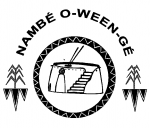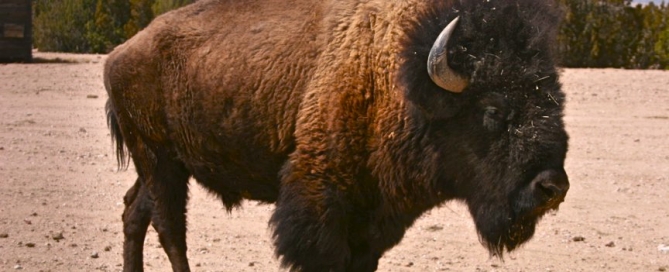Manage and protect the natural resources and the health and well-being of the Nambe Pueblo people within the exterior boundaries of the Pueblo of Nambe.
Nambe Pueblo members have always used the areas natural resources for traditional and cultural purposes, including hunting, farming, pottery making, and wood gathering. Natural resources are crucially important to the members of the Pueblo since their current and future livelihood is largely dependent upon them. The Pueblo recognizes the high priority for the sustainable use of their natural resources and for the protection of their environment, including restoration and improvement where necessary and feasible.
Nambe Pueblo members use the entire 19,093 acre reservation. The ground- and surface- water are used for drinking, watering cattle, traditional usage, fishing, recreation, and irrigation. The primary drinking water source for tribal communities is ground water. The lands are used for farming, hunting, grazing, traditional usage, obtaining clay for pottery, firewood, building materials, and recreation.
The Nambe Pueblo Department of Environmental and Natural Resources (DENR) was established in 1996. Within the DENR there are many programs and initiatives.
Surface Water Quality Program
T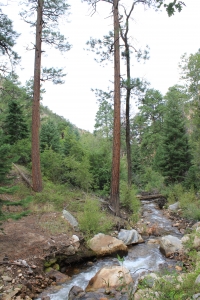 he Rio Nambe is the only perennial stream on the Pueblo and is a tributary to the Rio Grande. Flow varies throughout the year based on runoff and snowmelt. The Bureau of Reclamation built the Nambe Falls Reservoir in 1976. The reservoir has a surface elevation of 6,825 feet. It forms a lake of about 55 surface acres from a watershed of 35 square miles and contains a maximum storage of about 2,023 acre-feet of water. Both the falls and the reservoir are popular sites for tourism and various outdoor activities.
he Rio Nambe is the only perennial stream on the Pueblo and is a tributary to the Rio Grande. Flow varies throughout the year based on runoff and snowmelt. The Bureau of Reclamation built the Nambe Falls Reservoir in 1976. The reservoir has a surface elevation of 6,825 feet. It forms a lake of about 55 surface acres from a watershed of 35 square miles and contains a maximum storage of about 2,023 acre-feet of water. Both the falls and the reservoir are popular sites for tourism and various outdoor activities.
The primary DENR Water Quality program goal is to determine the overall quality of all water bodies (including arroyos) on the Pueblo. Objectives associated with this goal include:
- Protection of human health and the preservation of tribal lifeways
- Protection of ecosystem health
- Maintenance of water quality––particularly drinking water
The water quality monitoring program collects scientifically defensible samples from surface water locations to provide an accurate assessment of the quality of water resources on and impacting the Pueblo. Nambe has established EPA approved Water Quality Standards, most recently updated in 2017. The results of our routine sampling are compared to these standards to determine if any exceedances exist. Fortunately, apart from sediment loads after wildfires, the overall surface water quality on the Pueblo is very good. DENR also issues CWA §401 certification applications for activities proposed that may impact surface water quality, and may issue or deny the applications as appropriate.
Information on the surface water quality program can be obtained by contacting Tara Weston, Water Quality Technician, (505) 455-4416.
Solid Waste Program
The Nambe Solid Waste Transfer Station (TS) was constructed in 1998. Solid waste is collected in bins, one of which has a compactor, and is ultimately disposed of at the Caja del Rio Regional Landfill. The TS Operator is a part-time DENR staff member, and ensures the efficient operation of the facility.
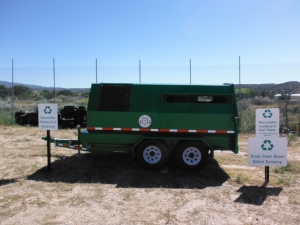 The Pueblo also has a successful recycling program, in which staff and residents use a recycling trailer at the TS, which is generally emptied at the Santa Fe County Buckman Road recycling facility once every week or two. Tires, white goods, certain hazardous materials, and e-waste are also collected and properly disposed of. DENR discourages illegal dumping, and has cleaned up most of the illegal dumpsites known to exist on the Pueblo.
The Pueblo also has a successful recycling program, in which staff and residents use a recycling trailer at the TS, which is generally emptied at the Santa Fe County Buckman Road recycling facility once every week or two. Tires, white goods, certain hazardous materials, and e-waste are also collected and properly disposed of. DENR discourages illegal dumping, and has cleaned up most of the illegal dumpsites known to exist on the Pueblo.
Information about the transfer station and solid waste can be obtained by contacting Frank Romero, Transfer Station Operator, or Steve Rydeen, DENR Manager, (505) 455-4420.
The Buffalo Program
The Nambe Pueblo Buffalo herd was established in 1994 with assistance from the Inter Tribal Buffalo Council. A fenced pasture was dedicated to the herd, and a number of Pueblo fields were volunteered for the production of alfalfa for supplemental feed during winters and periods of drought.
The Pueblo has a history of annual buffalo hunts on the eastern plains of New Mexico until the herds were eliminated after European contact. The introduction of buffalo to the Pueblo had great traditional meaning, and the ability to view these majestic animals has reinvigorated the Buffalo Dance at Nambe. The occasional slaughter of a surplus buffalo is conducted in a solemn, and respectful manner, and all parts of the animal are used as was done in the past. The meat is distributed to elders and other tribal members, and is highly prized for its health benefits and flavor.
The pastures are in need of rehabilitation, and so the herd size has been reduced until the lands can support a larger number of animals in a sustainable fashion.
A 2-mile trail loops around the buffalo pasture, offering stunning views of the Pueblo lands and the mountains beyond. The trail head starts at the Wellness Center and can be accessed throughout the day hours. Information about the buffalo and guided tours of the buffalo pasture can be arranged by calling, (505) 455-4420.
The Community Farm and Vineyard
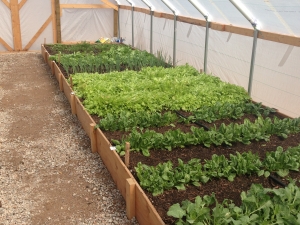 Our farm program continues to evolve and grow each year. Starting with a 2 acre community garden there has since been two vineyards (totaling 8 acres), three hoop houses, herb spirals, and a hugelkultur added. This program produces an abundance of organic fruits, vegetables, and herbs to be distributed to pueblo seniors, youth programs, and community members. The community farm allows pueblo volunteers and youth the opportunity to learn traditional and modern farming methods, learn the Tewa names of these plants, and supplement their diet with healthy food items.
Our farm program continues to evolve and grow each year. Starting with a 2 acre community garden there has since been two vineyards (totaling 8 acres), three hoop houses, herb spirals, and a hugelkultur added. This program produces an abundance of organic fruits, vegetables, and herbs to be distributed to pueblo seniors, youth programs, and community members. The community farm allows pueblo volunteers and youth the opportunity to learn traditional and modern farming methods, learn the Tewa names of these plants, and supplement their diet with healthy food items.
Information about and tours of the community farm and vineyard can be arranged by calling George Toya, Farm Program Manager, 505-455-4433.
